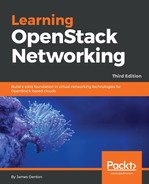The L2 population driver was introduced in the Havana release of OpenStack alongside the ML2 plugin. It enables broadcast, multicast, and unicast traffic to scale on large overlay networks constructed by OpenStack.
The goal of the L2 population driver is to inhibit costly switch learning behaviors by pre-populating bridge forwarding and IP neighbor (ARP) tables on all hosts. Because Neutron is seen as a source of truth for the logical layout of networks and instances created by users, it can easily pre-populate forwarding tables consisting of MAC addresses and destination VTEPs with that information. The L2 population driver also implements an ARP proxy on each host, eliminating the need to broadcast ARP requests across the overlay network. Each compute or network node is able to intercept an ARP request from an instance or router and proxy the response to the requestor. However, the L2 population driver does have limitations that will be discussed later in this chapter.
An alternative to using the L2 population driver is to rely on the use of multicast to propagate forwarding database information between hosts. Each host should be configured to subscribe to a multicast group configured outside of OpenStack. If not properly configured, broadcast messages may be used in lieu of multicast and may cause unnecessary chatter on the network. The configuration of multicast is outside the scope of this book.
